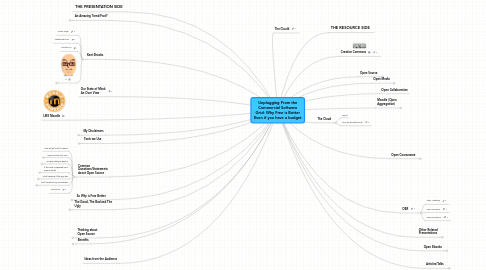
1. LMS Moodle
2. Kent Brooks
2.1. WOSC Page
2.2. Kentbrooks.com
2.3. Contact Me
2.4. 2
2.4.1. MiiCharacters
2.4.2. Create Mii
2.4.3. My Avatar Editor
3. An Amazing Trend/Fact?
3.1. 1
4. Ideas from the Audience
5. Our State of Mind: An Over View
6. So Why is Free Better
6.1. Reason #1 All the really really smart people work for someone else and live somewhere else
6.2. Reason #2 We can give stuff away
6.2.1. Software for Starving Students
6.3. Reason #3 We can give our teachers a better selection of tools and becasue of reason
6.4. Reason #4 We can save money on licensing software.
6.5. Reason #4.5 Because of Reason 4 you can save money on hardware
6.6. Reason # 5 Free will allow us to Automate Humanization
6.6.1. 5
6.7. Reason #6 Free Drive Innovation
6.8. Reason #7 We are Us...They are Them...but Everyone Expects us to be Them
6.8.1. 4
6.9. Reason #8 We have been able to reallocate resources to improve teaching and learning
6.9.1. New node
7. My Disclaimers
7.1. Unplugging Not Unplugged
7.1.1. Prezi: Free for Education
7.1.1.1. Moving beyond Slide
7.1.2. Mindmeister: Not Free but Cheap
7.1.3. ...and by the way I like and still use Microsoft
7.2. Free and Open Source are not always the same...but are sort of the same
8. Common Questions/Statements about Open Source
8.1. Who will you call at 2:00am
8.2. Open Source Isn't Free
8.2.1. Reduced TCO
8.2.1.1. Additional Software
8.2.1.2. Staffing
8.2.1.3. LMS Licensing
8.2.1.4. Hosting
8.3. You get what you pay for
8.3.1. 3
8.3.2. Wiki Moodle 1.4 (2004); Bb Learn 9.1 (2010)Blog: Moodle 1.5/1.6 (2005) BbLearn 9.1 (2010)
8.3.3. Quicker Pace of Develpment
8.4. If the code is exposed can't anyone hackit
8.4.1. Site Wide SSL
8.4.2. 0 incidents
8.5. What happens if the guy dies
8.5.1. Photo by Steve Jurvetson: Flicker Creative Commons
8.5.2. Question Source: Presentation by Patrick Masson CTO UMass Online "Technology during an Economic Crisis: The Benefits of Open Source" Augus 2010
8.6. You'll Need to hire a Developer
8.6.1. Savings from LMS in conjunction with increased enrollments has allowed Western to hire Instructional Design Support, Online Coordinator and
8.7. What is it?
9. The Good, The Bad and The Ugly
9.1. The Good
9.1.1. There Are Options
9.1.2. A significant user base
9.1.3. Many coders posting regular updates
9.1.4. Backed by VCs, a major company, or foundation
9.1.5. Uses a standard open source license (GPL)
9.2. The Bad
9.2.1. One Coder
9.2.2. Working out of a garage
9.2.3. Last update 3 years ago
9.2.4. No Stated users
9.2.5. Stated License Use this as you wish
9.3. The Ugly
9.3.1. Not Thinking you have a Choice
10. THE PRESENTATION SIDE
11. Thinking about Open Source
11.1. There is not One Killer Application/Solution
11.2. If you are Risk Averse don't try this at work
11.3. Major open source software applications are written at least as well as leading commercial products (often by the same people),
11.4. Enthusiastically supported by expert and helpful developers (as opposed to knowledge-free call center staff),
11.5. Transparently licensed (via industry-standard agreements).
11.6. The hazards of open source are those typically discussed as objections by “experts” about commercial software unstable or insecure software, availability of support, and legal issues.
12. Benefits
12.1. Reduced TCO
12.2. Quicker Pace of Development
12.3. Stability
12.4. Integration and interoprability
12.5. Transparency
12.6. Reliability
12.7. Overview of Benefits
13. Tools we Use
13.1. Open Source
13.1.1. Web Page: CMS Made Simple
13.1.2. Web Conferencing
13.1.2.1. DimDim
13.1.2.2. Big Blue Button
13.1.3. Open Office
13.1.4. Word Press
13.1.5. Web Services
13.2. Free
13.2.1. Google Apps for Education
13.2.2. Prezi
13.3. Commercial
13.3.1. Turnit In
13.3.2. Big Web Apps
13.3.3. MS Office
13.3.4. Site Pal
13.3.5. Voice Thread
14. The Clould
15. Creative Commons
16. Open Media
16.1. Open Photo
16.2. Public Domain Photos
16.3. New node
17. Open Collaboration
18. Moodle (Open Aggregation)
18.1. Moodle
18.1.1. Blackboard Course Converter
18.1.2. Security Issues
18.2. Moodle in Montana
18.3. North Carolina CC System Moodle Assessment Reports
18.4. Me and My Friend Moodle
19. Open Courseware
19.1. Merlot
19.2. Open Learn Learning Space
19.3. Digital Enterprise
19.4. Open Courseware Finder
19.5. NSDL
19.6. Carnegie Mellon
20. OER
20.1. Khan Academy
20.2. OER Commons
20.3. OER Consortium
21. Open Ebooks
21.1. Alex Catalogue of Electronic Texts
21.2. Project Gutenberg
21.3. University of Virginia Library
21.4. Manybooks.net
21.5. Oreilly Open
21.6. Gabriel Gurley Open Office
21.7. Open Text Book
21.8. Flat World Knowledge
21.8.1. Build Your Own
21.8.2. Remixable
